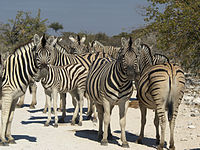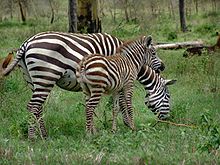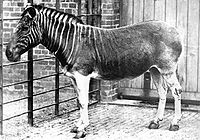
Plains zebra
Background to the schools Wikipedia
SOS Children produced this website for schools as well as this video website about Africa. See http://www.soschildren.org/sponsor-a-child to find out about child sponsorship.
| Plains Zebra | |
|---|---|
 |
|
| Grant's Zebra (E. quagga boehmi) | |
| Conservation status | |
|
Least Concern
|
|
| Scientific classification | |
| Kingdom: | Animalia |
| Phylum: | Chordata |
| Class: | Mammalia |
| Order: | Perissodactyla |
| Family: | Equidae |
| Genus: | Equus |
| Subgenus: | Hippotigris |
| Species: | E. quagga |
| Binomial name | |
| Equus quagga Boddaert, 1785 |
|
| subspecies | |
|
E. q. quagga † |
|
 |
|
| Range map of The Plains zebra | |
The Plains zebra (Equus quagga, formerly Equus burchelli), also known as the Common zebra or the Burchell's zebra, is the most common and geographically widespread form of zebra, once being found from the south of Ethiopia right through east Africa as far south as Angola and eastern South Africa. The Plains Zebra is much less numerous than it once was, because of human activities such as hunting it for its meat and hide, as well as encroachment on much of its former habitat, but it remains common in game reserves.
Physical description
The Plains Zebra is mid-sized and thick bodied with relatively short legs. Adults of both sexes stand about 1.4 meters (4.6 ft) high at the shoulder, are approximately 2.3 meters (8 ft) long, and weigh about 294 kg (646 lbs) however males may weigh 10% more than females. Like all zebras, it is boldly striped in black and white and no two individuals look exactly alike. All have vertical stripes on the forepart of the body, which tend towards the horizontal on the hindquarters. The northern populations have narrower and more defined striping; southern populations have varied but lesser amounts of striping on the underparts, the legs and the hindquarters. Southern populations also have brown "shadow" stripes between the black and white coloring. The first subspecies to be described, the Quagga which is now extinct, had plain brown hindquarters. (Technically, because the Quagga was described first as E. quagga, the proper zoological name for the most common form of the Plains Zebra is E. quagga burchelli.)
Ecology
Plains zebras live in eastern and southeastern Africa where there are only two seasons; wet and dry. Zebras rely on rainfall for food and water and thus have to go on great migrations to follow the rains. The zebras will migrate up to 700 miles for food. Other grazers also must do the same thing. Plains zebras can not survive very long without water and must be at least 25-30 kilometers from a water source.
Unlike many of the large ungulates of Africa, the Plains Zebra does not require (but still prefers) short grass to graze on. It eats a wide range of different grasses, preferring young, fresh growth where available, and also browses on leaves and shoots from time to time. In consequence, it ranges more widely than many other species, even into woodland, and it is often the first grazing species to appear in a well-vegetated area. A zebra's digestive system works quickly and can extract more protein from the fibrous and poorest plant parts. Thus zebra are less picky in foraging but they do spend much time eating. Only after animals like zebras have cropped and trampled the long top grasses, which are low in protein, do the other grazers like Blue wildebeests and Thompson's gazelles move in to eat the newly exposed and more nutritional short grasses.
The Plains zebra's main predators are lions and spotted hyenas. Nile crocodiles are also great threats during river crossings. Wild dogs, cheetahs and leopards also prey on zebras, although the threats they pose are generally minor. For protection from land predators the Plains Zebra retreats into open areas with good visibility at night time.
Lifestyle
The Plains Zebra is highly social and usually forms small family groups consisting of a single stallion, one, two, or several mares, and their recent offspring. Bachelor males either live alone or with groups of other bachelors until they are old enough to challenge a breeding stallion.
A stallion forms a harem by abducting young mares from their families. When a mare reaches sexual maturity she will exhibit the estrous posture which invites the males. However she is usually not ready for mating at this point and will hide in her family group. Her father has to chase off stallions attempting to abduct her. Eventually a stallion will be able to defeat the father and include the mare into his harem.
A stallion will defend his group from bachelor males (as well as predators), unless the male grew up with the stallion. At that point the stallion will allow one mare for his "friend." When challenged, the stallion would issue a warning to the invader by rubbing nose or shoulder with him. If the warning is not heeded, a fight breaks out. Zebra fights often become very violent, with the animals biting at each other's necks, heads or legs, wreastling to the ground, and occasional kicking. Sometimes a stallion will lay still on the ground like he's surrendered but once the other male lets up the stallion will strike and continue the fight.
Mares exist in a hierarchy with the alpha female being the first to mate with the stallion and being the one to lead the group. When new mares are added to the group, they are met with hostility by the other mares. Thus the stallion must shield the new mares until the aggression subdues.
Zebras strengthen their social bonds with grooming. Members of a harem nip and scrape along the neck, shoulders and back with their teeth and lips. Mothers and foals groom the most often followed by siblings. Grooming shows social status and eases aggressive behaviour.
Plains zebra groups often come together in large herds and migrate together along with other species such as wildebeests. Wildebeests and zebras generally coexist peacefully and will alert each other to predators. However in one case, a gang of young zebra stallions isolated and harassed a wildebeest calf while keeping the mother at bay. The zebras chased and bit the young calf repeatedly. One zebra even trampled over it. The group eventually lost interest and the calf survived. A similar incident happened when a lone wildebeest calf wandered too close to a gang of stallions and was kicked to death.
Reproduction
Mares may give birth to one foal every twelve months. She nurses the foal for up to a year. Like horses, zebras are able to stand, walk and suckle shortly after they're born. Plains zebra foals are protected by their mother as well as the head stallion and the other mares in their group. Even with parental protection up to 50% of zebra foals are taken by predation, disease and starvation each year. It is possible that zebras practice infanticide and feticide, although such incidences have only been observed in captive individuals.
Young male zebras eventually leave their family groups. This is not because of sexual maturity or being kicked out by their fathers but because their relationship with their mothers have faded after the birth of a sibling. The young stallion then seeks out other young stallions for company. Young females may stay in the herd until they are abducted by another stallion.
Subspecies
In 2004, C.P. Groves and C.H. Bell did investigations on the taxonomy of the zebra's genus Equus, subgenus Hippotigris. They published their research in Mammalian Biology. They revised the subspecies of the Plains Zebra Equus quagga. Six subspecies are recognizable. The completely maneless Somali population may represent a seventh subspecies: Equus quagga isabella (Ziccardi, 1958). This subspecies may be valid, but at present there is no evidence that it is.
- Quagga, Equus quagga quagga Boddaert, 1785 †
- Burchell's Zebra, Equus quagga burchellii Gray, 1824
- Grant's Zebra, Equus quagga boehmi Matschie, 1892
- Selous' zebra, Equus quagga borensis Lönnberg, 1921
- Chapman's Zebra, Equus quagga chapmani Layard, 1865
- Crawshay's Zebra, Equus quagga crawshayi De Winton, 1896.
Conservation
The Plains zebra’s range has diminished in modern times. While the population remains stable, zebras are threatened by hunting, for their hide and meat, and habitat change from farming. They compete with livestock for food. One subspecies, the quagga, is now extinct. Nevertheless, Plains zebras are protected in most of their range. They are an important economic source in tourism.








